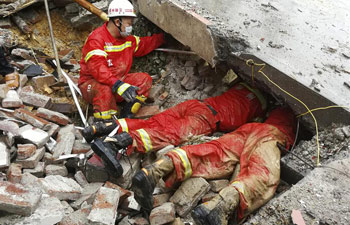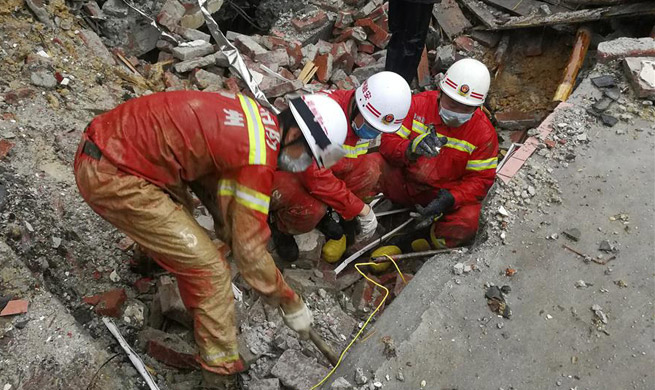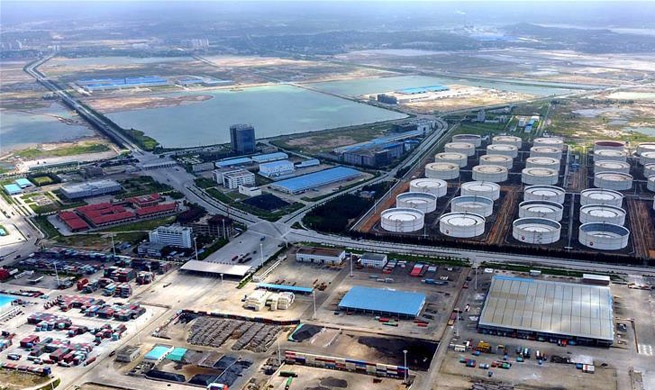NEW DELHI, Aug. 14 (Xinhua) -- A toilet revolution is going on in India where a large number of population still does not have access to proper sanitation.
Indian households, especially in the countryside, have in fact been known to be averse to having toilets inside homes. This is due to certain cultural and religious attitudes linked to toilets at homes which has a temple built inside the courtyard. Thus, in order to keep their homes clean, people unhesitatingly relieve themselves in open fields.
Even after 70 years of Independence, close to 48 percent of India's urban population remain without access to toilets while in rural areas, the number stands at 60 percent, according to available data.
Now, to eradicate this menace, Prime Minister Narendra Modi's pet project -- Swachh Bharat Mission (Clean India Mission) launched in 2014 -- is forging ahead to eliminate open defecation by constructing toilets in every household in the country by 2019.
Modi has also called upon politicians and corporates to build toilets to end open defecation and promote good health. And India is making impressive headway with comprehensive planning towards achieving a goal that has become the need of the hour.
Officials revealed that various ministries have been roped in to chalk out the modalities to ensure effective implementation of the program that was launched a few years back.
For example, the Ministry for Drinking Water and Sanitization worked in close tandem with the Ministries of Health and Family Welfare to build supporting infrastructure like water supply, sewerage and waste management to move ahead in a planned manner.
The government has also roped in non-governmental organisations for additional resources and manpower. This ensured that there is supporting infrastructure to support the toilet structures for the long term.
"Open defecation is rife, and remains a major impediment in achieving the millennium development goals. Since the government brought this issue out of the closet and into the public arena, having toilets inside homes and maintaining hygiene is no longer a taboo," said Nandini Vyas, director of a Delhi-based non-government organisation that promotes sanitation and hygiene.
"When we approach villages now, people come out in large numbers to listen to us. They take leadership roles in promoting toilet construction. Since funding has become easier, I think India will soon achieve its goal of ending open defecation," she added.
One important part of the Clean India project is ensuring dignity for women. For this, women are made key partners in overlooking constructions of toilets and raising awareness about challenges associated with open defecation like spread of diseases and eventual deaths.
"Women were supposed to be key change-makers in eliminating defaecation and constructing toilets. The government started roping in women from the grassroots -- panchayats (local bodies in villages) were made partners in this project and women were given roles to emphasize the need for toilets inside homes and in also in schools. The target was dual -- besides sanitation, the idea was to improve women's safety and literacy," said Khemi Kanti, a sanitation activist.
According to the Ministry of Human Resource Development data, close to 10 percent of the 1.1 million schools in India do not have toilet facilities for female students. As a consequence, girls leave school on average at an earlier age than their male contemporaries.
Lack of toilets in homes also puts women at risk -- non-government organisations have data to claim women are raped and killed on their way to relieve themselves in the open. However, things are getting better in rural India at least where access to sanitation has risen by 51 percent.
"Earlier we had to go to open fields at dawn. Sometimes, we had to take a male member of the family along because there were men from opposite village who would tease us. Now we are happy to have toilets inside homes. It makes us feel safe and prevents spread of infections as well," said Rajkumari Saha, a woman near a village in Greater Noida, some 50 km from Delhi.
The government moved with alacrity on its plan and by the end of 2016, claimed to have constructed nearly 80 lakh toilets in the countryside.
However, the challenge is spread far and wide. So the government has roped in state-owned and public sector firms to construct toilets in schools in various states to effectively use their corporate social responsibility funds and mobilise money for the purpose.
"It will be quite a task to meet the goal of toilets' construction in schools by 2019 and the government will have to rush against the deadline. The quality and long-term maintenance will be other issues," said Suman Baru, an educationist based in Delhi.
"But even if they are able to make progress towards achieving 75 percent of the set goal, it will be a good boost to education, especially for the girls in the country. It will also help curb child labour, especially manual scavenging and eradicate diseases among children like mental and cognitive stunting and diarrhoea, which spread because of unhygienic practices," she added.

















